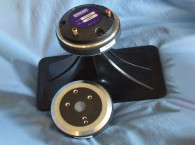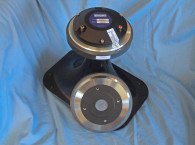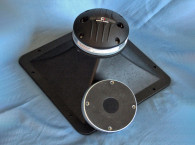




Today, Radian, based in Orange, CA, is a serious player in the OEM loudspeaker component business, the sound contractor/fixed installation market, and the portable/tour sound industry. With more than two decades of success under its belt, Radian is well into its third decade as a pro sound manufacturer and is introducing new pro sound transducers (e.g., the LT6 pro sound ribbon).
Voice Coil has featured several of Radian’s neodymium series of compression drivers, including the 960PB and the 950PB 2” exit aluminum diaphragm compression drivers (November 2014), the 745NEO with both the aluminum and beryllium diaphragms (October 2017), and the 951PB neodymium compression driver (July 2018). In this one, I characterized one of Radian’s ferrite 1.4” aluminum diaphragm compression drivers, the 745PB (see Photo 1).
If you are familiar with Radian compression drivers, or have read some of the past explications of Radian neodymium compression driver Test Bench reports, the 745PB has the expected rich feature set of other Radian compression drivers. This includes a 1.4” throat diameter, a 165 mm × 19 mm ferrite magnet motor, high-temperature 76.2 mm (3”) diameter polyimide voice coil former wound with a copper-clad aluminum edgewound ribbon wire voice coil, 75 W continuous power handing (150 W program power handing), a self-aligning field-replaceable diaphragm assembly, and the most important feature — a proprietary processed and hardened aerospace-grade aluminum alloy diaphragm over a three-slit phase plug.




Although Radian does not produce horns for its compression drivers, it does measure its compression drivers with Eminence horns, and provided an Eminence H14EA 60° × 40° 1.4” exit cast-aluminum exponential horn. For a compression driver, the 745PB weighs a substantial 11.2 lbs. I almost never have any subjective experience with the transducers that I characterize in Voice Coil’s Test Bench. However thanks to Radian’s generosity, the 2” 950PB samples from the November 2014 issue ended up in a far-field monitor that I designed for my home recording studio. These, of course, have the same aluminum alloy diaphragm as the 745PB. The cabinets were built by my friend and Triad’s chief engineer David Nelson, and utilized a B&C Speakers 15BG100 15” neodymium motor woofer with a NBR surround, an Eighteen Sound XR2064C 60° × 40° 2” throat cast-aluminum horn, and a high-performance passive network that included Goertz foil inductors, Jantzen capacitors, and Mundorf M-Resist resistors.
Subjectively, this speaker is incredibly musical, detailed, and extremely easy to listen to — certainly a goal for all monitors. To test the Radian 745PB/H14EA combination, I used the LinearX LMS analyzer to produce the 300-point stepped sine wave impedance plot shown in Figure 1. The solid black curve represents the Radian 745PB mounted on the Eminence H14EA horn and the dashed blue curve represents the compression driver without the horn. With a 5.68 Ω DCR (Re), the minimum impedance of the 745PB/H14EA was 7.92 Ω and at 2.64 kHz.
For the next set of SPL measurements, I free-air mounted the Radian 745PB/H14EA combination without an enclosure and measured both the horizontal and vertical on and off axis at 2 V/0.5 m (normalized to 2.83 V/1 m). Once again, I used the Loudsoft FINE R+D FFT analyzer to product both horizontal and vertical plane SPL data from 0° on-axis to 60° off-axis.




Figure 2 illustrates the on-axis frequency response of the compression driver/horn combination, which is smooth ±2.6 dB from 700 Hz to 10 kHz with no major anomalies extending to nearly 20 kHz. Figure 3 depicts the on- and off-axis (0° to 60°) response in the horizontal plane. Figure 4 displays the normalized horizontal plane response. Figure 5 shows the 180° horizontal polar plot (in 10° increments with 1/3 octave smoothing applied) generated by the CLIO Pocket analyzer. Figure 6 displays the on- and off-axis to 60° response in the vertical plane, while Figure 7 depicts the normalized vertical plane response. Figure 8 shows the CLIO Pocket-generated vertical plane polar plot (in 10° increments with 1/3 octave smoothing applied). Last, Figure 9 illustrates the two-sample SPL comparison showing the two Radian 745PB compression drivers less than 1 dB throughout the operating range of the transducer to 10 kHz.
For the remaining tests, I again set up the Listen AudioConnect analyzer, the SoundCheck 16 software, and the Listen 1/4” SCM microphone to measure distortion and generate time-frequency plots. For the distortion measurement, I again mounted the 745PB/H14EA combination in free-air in the same manner as was used for the frequency response measurements, and set the SPL to 104 dB at 1m (1.72 V, determined by using a pink noise stimulus generator and internal SLM in the SoundCheck 16 software). Then, I measured the distortion with the measurement microphone located 10 cm from the mouth of the horn. This produced the distortion curves shown in Figure 10 (the red curve = second harmonic, the blue curve = third harmonic). Next, I set up SoundCheck 16 to generate a 2.83 V/ 1 m impulse response for this driver/horn combination and imported the data into Listen’s SoundMap Time/Frequency software. Figure 11 shows the resulting CSD waterfall plot. Figure 12 shows the STFT plot.
I found the 745PB displays excellent performance for a fairly high power handling package, and has a ferrite motor compression driver build quality that is on par with the best players in this industry. For more information, contact Radian Audio Engineering, at 600 N. Batavia St., Orange, CA 92868, by phone at 714-288-8900, or visit www.radianaudio.com. VC
This article was originally published in Voice Coil, December 2018.







